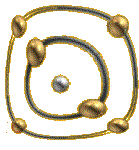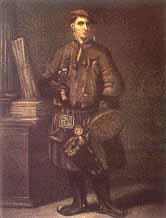AwayMave Home Page | IEPPP Home Page | 406 Module Home Page | University Home Page | VP Home Page |
||
 |
||
Reason, nature and the human being in the West: Part 3 |
||
AwayMave Home Page | IEPPP Home Page | 406 Module Home Page | University Home Page | VP Home Page |
||
 |
||
Reason, nature and the human being in the West: Part 3 |
||
Though the corpuscularian project was pursued throughout the 18th Century, another approach to setting out the order that was to be found in nature, thought of objectively, in the end became dominant. This was the approach that pursued classification.
The 18th Century preoccupation with classification is often glossed as a preoccupation with description:
"The primary task of the natural historian [in the 18th C] is to provide complete descriptions of animals, vegetables and minerals." (Jardine, The Scenes of Inquiry, p.12.)
But setting out the order of nature is more than describing the things that belong to nature.
It is displaying the proper relation between the things in nature.
It may be that this can only be done on the basis of 'correct' and 'complete' descriptions. But it goes beyond describing.
What is meant by "proper"? What do we mean by saying that the 18th C project was one of displaying the "proper" relation between things of nature?
It is the project of revealing the true degree of similarity between any two things.
Let me try and explain what might be meant by a 'natural' classification in an 18th Century context by thinking in terms of how one might classify a group of Lego stones....[More]
The 18th Century conception of how animals and plants - and stones - might be "naturally" grouped into coherent categories was to think it could be done on the basis of shared 'characteristics'. (I argue this in my 'Foucault & the History of Classification Theory'.
Adanson (Familles des Plantes, 1763) was perhaps the boldest. In the case of plants, he proposed that a complete description of each should be drawn up and a classification derived based on numbers of shared characters.
 |
|
Linnaeus, courtesy Berkeley University, who have an introductory article. Uppsala University offer to show you Linnaeus garden. |
Others (e.g. Linnaeus) despaired of carrying through such a programme successfully and settled for approximations to the "natural" system Adanson's scheme was aimed at establishing. Buffon took the view that there were no natural groupings (above the species) - species were scattered about the similarity space.
Notice what assumptions were being made by this conception of natural categories of things.
The first is that you could draw up a complete list of characters which a plant (in the case of plant classification - and let's stick to that) might have, so that you could go down the list and check off whether a given specimen had it or not.
This creates objectivity: anybody possessed of this understanding of what it was to describe a plant would describe a given plant in the same way. The check-list of possible characters served as a kind of template through which the plant is to be viewed, restricting the attention of the observer to certain features only.
Foucault puts it this way: a plant description had to be articulated in terms of just five elements of structure: roots, stem, leaves, flowers, and fruits; and four variables:
"the form of the elements, the quantity of the elements, the manner in which they are distributed in space in relation to each other, and the relative magnitude of each element." (Foucault The Order of Things Engl. Trans., London,1970, Tavistock, p. 134)
The second is that the characters of a plant which are relevant to its placing in the natural order are observable, by which was meant (overwhelmingly at any rate) characters which were visible.
All classification schemes in the 18th century relied on features that were visible: you inspected the flower, for example, and noted how many stamens, where the ovary was rooted in relation to the stamens, how many petals, how many sepals, the geometrical configuration their arrangements displayed: and so on. Where other features of the plant came in, you inspected them visually as in the case of the flower: Was the stem hirsute? How tall? How did it branch, i.e. according to what geometrical pattern?
The 18th century concentration on the visible is something Foucault brings out. But it is not peculiar to him.
Concentration on the visible was not inescapable. In earlier periods all sorts of things had been thought relevant to a scientific placing of a thing. Renaissance encyclopaedias had been highly catholic in the matter they included: plant's medicinal properties, their uses for food, for clothing, myths about them, their place in literature etc.
But in the 18th century, the visible was taken up and concentrated on to the exclusion of almost everything else.
Describing plant in the 18th century was therefore largely a matter of describing visibilities: that is the second assumption I have picked out. And describing those visibilities was a matter of going down a finite check-list of (visible) characters: that is the import of the second assumption.
What do you think?Do we engage in the project of 'setting out the order of nature' today? |
If we are asking about the concept of a plant or animal the 18th Century deployed, Foucault expresses his answer in terms of conceptual space.
To say there are different épistèmes is to say there are different conceptual spaces.
His self-appointed task could be said to be to describe the conceptual space in which animals and plants are located in the 18th Century.
What he says is that they were all laid out on table.
He is referring both to a flat-topped table, and tot he sort of table in which figures are laid out on paper, timetables, for example.
A table is in either case two-dimensional. The conceptual space in which animals and plants are located is two-dimensional.
I have explained that the 18th Century saw plants as configurations of visibilities. Things were reduced to descriptions of the visual fields they represented. This is the sense in which the conceptual space they occupied was two-dimensional.
Note this is not to say that the plant was thought not to have an inside, to be a surface, a two-dimensional object. We are talking of "conceptual" space.
In the 18th Century then the two-dimensional table you have is of differences and identities.
This becomes three-dimensional when it becomes recognised that these differences and identities are the surface manifestations of an underlying organisation: as it does in the19th Century.
Revised 07:05:04
IEPPP 406 Part 3 Home Page
IEPPP 406 Home Page
Reason, Nature and the Human Being in the West
Part of a module of the MA
in Values and the Environment Lancaster University
Send Mail to the Philosophy
Department